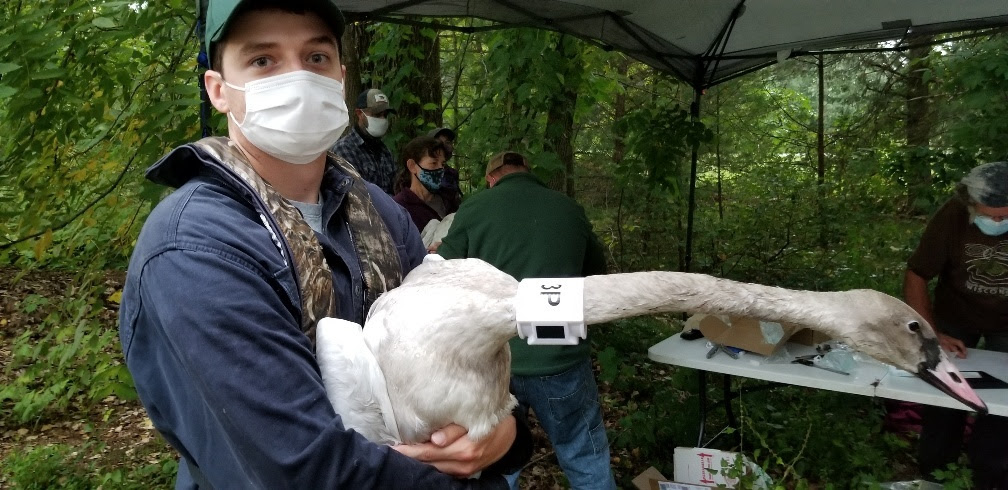Successful Reintroduction Effort Paves The Way
For New Regional Insights

DNR wildlife biologist Jeff Williams holds a trumpeter swan. / Photo Credit: Wisconsin DNR
MADISON, Wis. – The successful recovery of trumpeter swans in Wisconsin and other western Great Lakes states is spurring a new regionwide effort to better understand the migration routes and winter habitats of these birds, the largest in North America and named for their resonant calls.
The Wisconsin Department of Natural Resources, partners in other western Great Lakes states and the Canadian province of Ontario are corralling trumpeter swans late this summer and outfitting dozens of them with GPS transmitters. These neck collars record the birds’ location every 15 minutes and show where they stop to rest and fuel up during their migration, daily flight duration and where they spend the winter.
“Trumpeter swans are a phenomenal success story. The original plan for the Interior Population called for 2,000 birds and the most recent population estimates were over 30,000 across the region — and that doesn’t include cygnets,” said Taylor Finger, a DNR wildlife biologist and chair of the swan committee for the Mississippi Flyway Council.
Now, those large populations allow for, and underscore the need for, research to help reveal more about the swans’ ecology to better inform future management for what’s known as the Interior Population, Finger said. The Interior Population includes birds in Wisconsin, Minnesota, Michigan, Iowa, Ohio and Ontario.
Sumner Matteson, an avian ecologist for DNR’s Natural Heritage Conservation Program and the leader of Wisconsin’s trumpeter swan recovery efforts over the past three decades, said that Wisconsin research in the early 2000s revealed where some Wisconsin birds were overwintering.
“This regional project will give a fuller picture of trumpeter ecology so hopefully it will help inform better management of trumpeter swans in the flyway,” Matteson said.
Minnesota, which has the largest number of birds in the Interior Population estimated at 17,000 in 2015, leads the study, and David Wolfson, a PhD student at the University of Minnesota, is coordinating it.
To aid this new Great Lakes regional research effort, Wisconsin DNR has contributed eight collars and the Great Lakes Indian Fish and Wildlife Commission has contributed two. As of Sept. 22, biologists had placed collars on five birds, three in central Wisconsin and two in northwestern Wisconsin. Watch a field video of the release of trumpeter swans after having GPS collars placed on them.
“GLIFWC member tribes are excited that waabizii (swans) are again gracing this part of their native range, and we look forward to collaborating in this important study to help us better understand this culturally significant species and its needs,” said Peter David, GLIFWC wildlife biologist.
Wisconsin Recovery Powered By Past Wetland Conservation, Partnerships And Public Interest
Wisconsin’s population was estimated at 5,000 trumpeter swans in 2015 and is now upwards of 6,000 birds, excluding cygnets, a far cry from the 1980s, when DNRs Natural Heritage Conservation program began recovery efforts.
Wetland habitat loss and market hunting for feathers, skins and meat led to the extirpation of the trumpeter swan from Wisconsin by the late 1800s. The recovery started gaining traction in 1989 after DNR, working with many public and private partners, began collecting wild trumpeter swan eggs in Alaska, hatching and raising the birds and releasing them into wetlands.
This story is retold in Cygnus Buccinator: A comeback for the Ages in the summer 2019 Wisconsin Natural Resources magazine and in videos on DNR’s Back From the Brink Youtube playlist.
Matteson says this new research is an extension of the success of trumpeter swan restorations across the region due to partnerships and wetland conservation initiatives as well as the public embrace of trumpeter swan recovery efforts.
“We owe a lot of our success to earlier conservation of wetlands and to a very supportive public,” Matteson said. “I never imagined 30 years ago that we’d have this many, and it is gratifying to see the excitement today of so many biologists and partners working on this project.”
How To Help This New Research Effort
Learn more about the project and track the locations of marked swans on the Interior Population Trumpeter Swan Migration Ecology and Conservation website.
People seeing a marked swan can contribute to data collection efforts by reporting what the swan was doing and where it was located. Fill out a Google form at: https://forms.gle/



